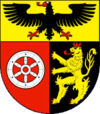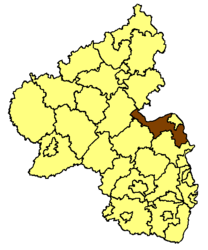- Mainz-Bingen
-
Mainz-Bingen — District — Country  Germany
GermanyState Rhineland-Palatinate Capital Ingelheim Area - Total 605.85 km2 (233.9 sq mi) Population (31 December 2010)[1] - Total 202,310 - Density 333.9/km2 (864.9/sq mi) Time zone CET (UTC+1) - Summer (DST) CEST (UTC+2) Vehicle registration MZ Website mainz-bingen.de Mainz-Bingen is a district (Kreis) in the east of Rhineland-Palatinate, Germany. Neighboring districts are (from north clockwise) Rheingau-Taunus, the district-free cities Wiesbaden and Mainz, the districts Groß-Gerau, Alzey-Worms, Bad Kreuznach, Rhein-Hunsrück.
Contents
History
During the French occupation under Napoleon the district was part of the departement Donnersberg (fr.:Mont-Tonnerre). After the Congress of Vienna, the area north of the Nahe river went to the Prussian Rhine province, the biggest part however became part of the Grand Duchy of Hesse and was called Rhenish Hesse. In 1835 the district Mainz was created, when the province Rheinhessen was abolished. In 1852 the district Oppenheim was created, and took some of the area of the Mainz district; in 1938 this district was abolished again. The district became the current borders in 1969, when the districts Mainz and Bingen were merged.
Geography
The main river in the district is the Rhine, which forms all the border of the district to the east. In Bingen the river Nahe enters the Rhine, after flowing a short part through the district. The flanks of the Hunsrück mountains in the west of the district to the Rhine valley are used as wine hills. The southern part of the district is part of the Rheinhessische Hügellandschaft, its gentle hills and the good climate make it a farming area for vegetables, especially asparagus.
Coat of arms
The district coat of arms might be described thus: Per pale gules a wheel spoked of six argent and sable a lion rampant Or armed, langued and crowned of the first, in a chief of the last an eagle displayed of the third armed, langued and beaked of the first.

The charges in the coat of arms show the three historic states which influenced the district. In the chief (horizontal band at the top) is the Imperial eagle, on the dexter (armsbearer’s right, viewer’s left) side the Wheel of Mainz, and on the sinister (armsbearer’s left, viewer’s right) side the lion of the Palatinate (Kurpfalz). The coat of arms was designed by Dr. Hans Leitermann of Mainz, and was granted in 1970.
Towns and municipalities
Verband-free towns Verband-free municipality Verbandsgemeinden - 1. Bodenheim
- Appenheim
- Bubenheim
- Engelstadt
- Gau-Algesheim1, 2
- Nieder-Hilbersheim
- Ober-Hilbersheim
- Ockenheim
- Schwabenheim an der Selz
- 3. Guntersblum
- 5. Nieder-Olm
- 7. Rhein-Nahe [seat: Bingen am Rhein]
1seat of the Verbandsgemeinde; 2town References
- ^ "Bevölkerung der Gemeinden am 31.12.2010" (in German). Statistisches Landesamt Rheinland-Pfalz. 31 December 2010. http://www.statistik.rlp.de/fileadmin/dokumente/berichte/A1033_201022_hj_G.pdf.
External links
 Urban and rural districts in the State of Rhineland-Palatinate in Germany
Urban and rural districts in the State of Rhineland-Palatinate in Germany 
Urban districts Frankenthal · Kaiserslautern · Koblenz · Landau · Ludwigshafen · Mainz · Neustadt · Pirmasens · Speyer · Trier · Worms · ZweibrückenRural districts Ahrweiler · Altenkirchen · Alzey-Worms · Bad Dürkheim · Bad Kreuznach · Bernkastel-Wittlich · Birkenfeld · Bitburg-Prüm · Cochem-Zell · Donnersbergkreis · Germersheim · Kaiserslautern · Kusel · Mainz-Bingen · Mayen-Koblenz · Neuwied · Rhein-Hunsrück-Kreis · Rhein-Lahn-Kreis · Rhein-Pfalz-Kreis · Südliche Weinstraße · Südwestpfalz · Trier-Saarburg · Vulkaneifel · WesterwaldkreisCategories:- Districts of Rhineland-Palatinate
- Mainz
- 1969 establishments
Wikimedia Foundation. 2010.

